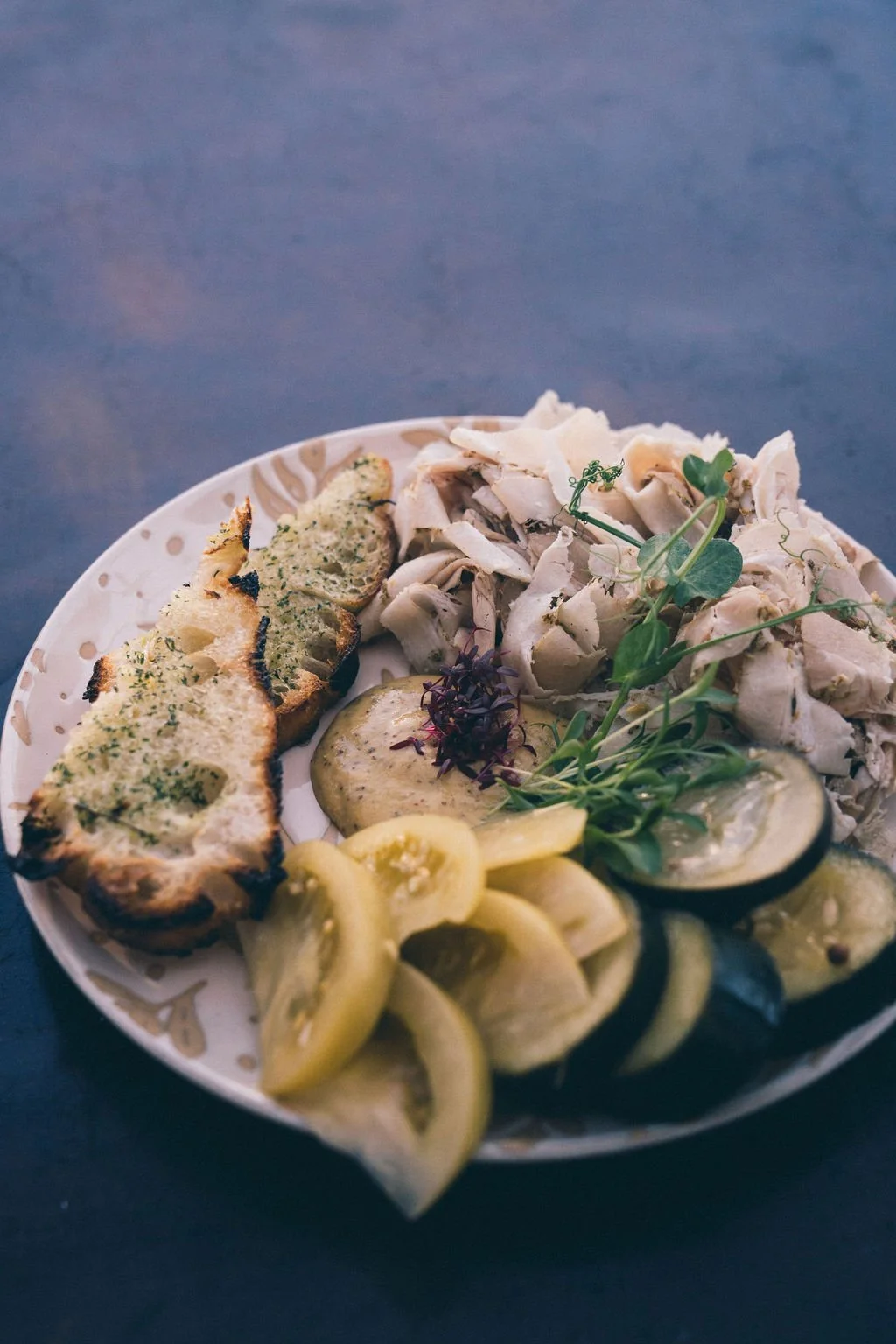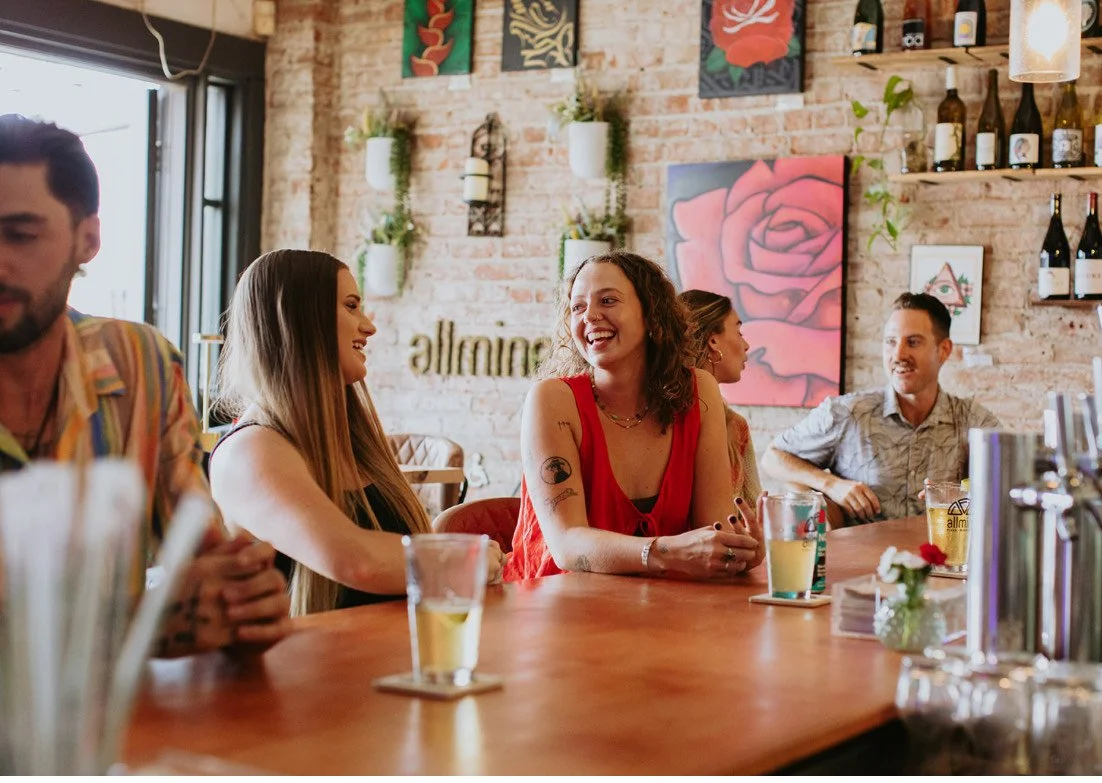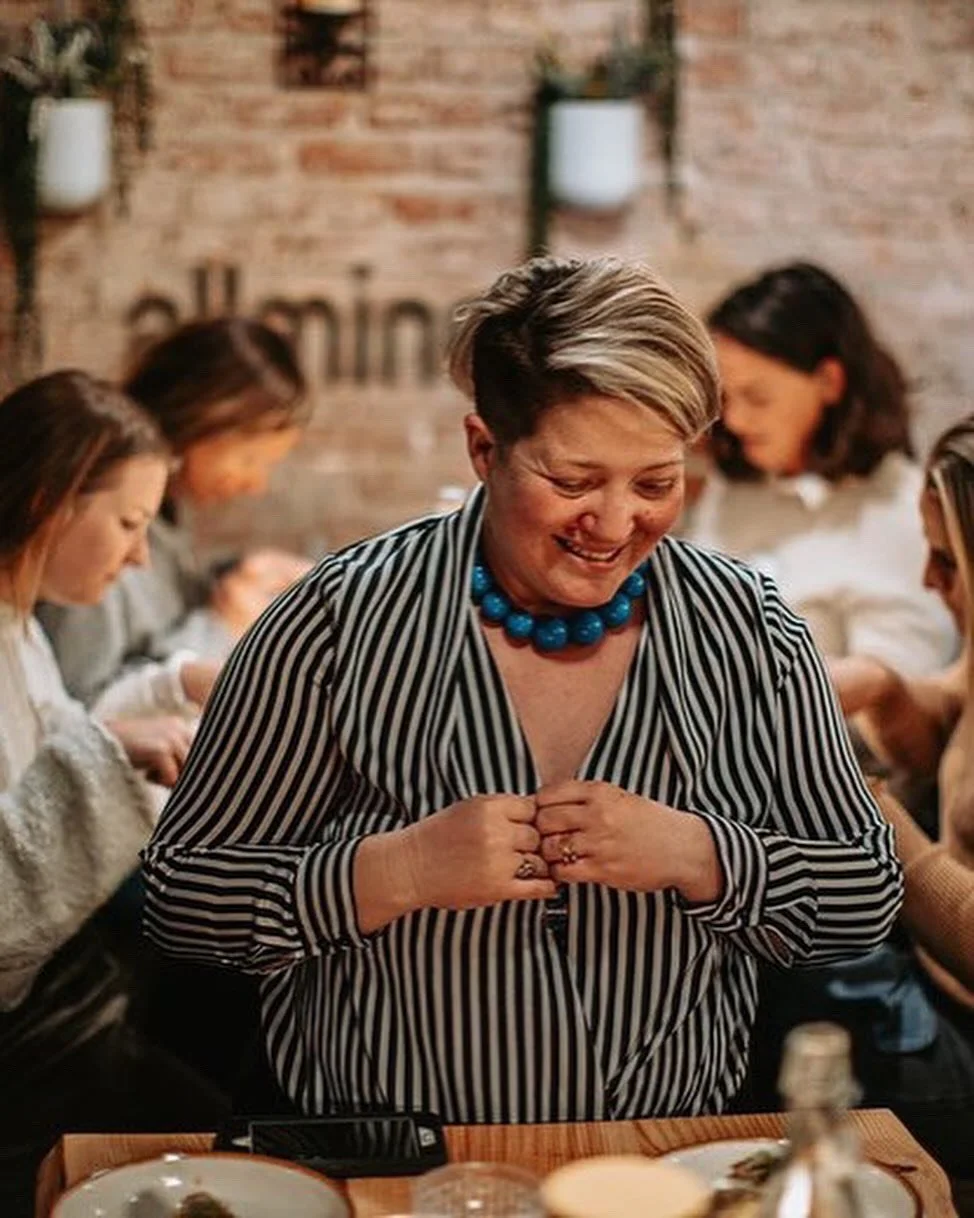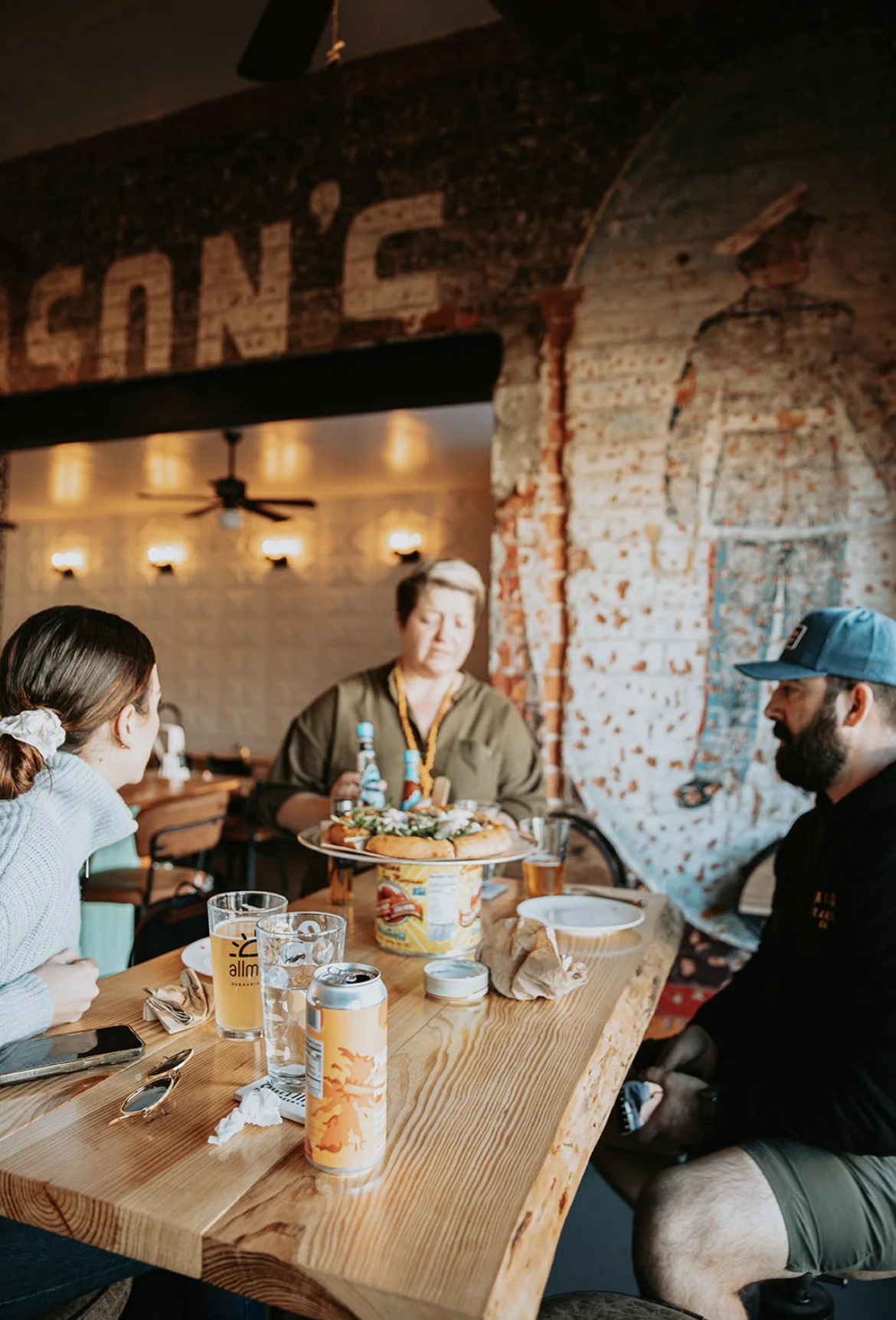A blog about hospitality, entrepreneurship, and building community.
When I opened Allmine, I thought I was opening a restaurant. And I was—but what I quickly learned is that a restaurant is rarely just a restaurant. Over time, I began to understand that I was also building something far less tangible and far more enduring: a gathering place, a living room for the neighborhood, a home for ideas and conversation, a space where food, people, and purpose meet and continue to shape one another. This blog grew out of that understanding.
Roxana’s Notes is where I reflect on what it means to live in this work of hospitality. It’s about the quiet, almost invisible gestures that make a guest feel at ease—the bread arriving warm enough to still feel alive in your hands, the pause before the second glass of wine is poured, the way a team moves together when the room is full. It’s about the bigger, less romantic realities too: the long nights spent reworking a menu, the uncertainty of keeping an independent restaurant steady in a changing economy, the heartbreak of watching other beloved places close their doors.
In my years as an entrepreneur, I’ve learned that a restaurant is an ecosystem as much as a business. It holds farmers and vendors, cooks and servers, neighbors who bring their friends, and families who make a tradition out of gathering around the same table. It holds their milestones and their rituals, their laughter and their silences. And it holds the weight of knowing that these connections don’t happen by accident—they’re built with care, choice by choice, every single day.
These notes aren’t business manuals. They aren’t marketing copy. They’re meditations on a life rooted in hospitality—sometimes practical, sometimes philosophical, often both. I write about why we choose ingredients that honor their origins, what it takes to keep a restaurant alive without losing its soul, and why a simple, well-made meal shared among people who care about each other can feel like an act of belonging.
Whether you’re another restaurant owner, someone dreaming of opening your own place, or simply a guest curious about the world behind the table, my hope is that you’ll find something here worth lingering over.
At its heart, this blog is about connection: between craft and care, between a restaurant and its guests, between the work we do and the lives we touch. It’s about food that hugs you back—and the people who make that possible.
Welcome to Roxana’s Notes.
From Soil to Soul
all the ingredients on this plate are made in house: the slow roasted porchetta, the pickles, the mustard and, of course, the bread.
allmine deepens our commitment to sustainability through partnership with Thompson Heritage Ranch
At allmine, we’ve always believed that what we serve on the plate should reflect what we value in the world. That every ingredient carries not just flavor, but a story — of how it was grown, who raised it, and the care it took to get here.
This week, we’re honored to begin sourcing all of our meat and eggs from Thompson Heritage Ranch, a regenerative farm in Ramona, California, led by rancher Ty Thompson. His methods are not just humane — they are restorative. His animals live on open, organic pastures. They eat clean, no-corn, no-soy diets he mills himself from locally grown grains. They’re rotated regularly to revitalize the land beneath their feet, contributing to a closed-loop ecosystem where nothing is wasted and everything has purpose.
“When you start with animals that are raised with integrity, you taste the difference — in flavor, in texture, in how it feels in your body,” says Executive Chef Sid Hilarides. “We’ve always made everything from scratch. This takes it to the next level — starting from the source.”
Regenerative farming is better for the land, for the animals, and for us. Meat raised this way is naturally higher in omega-3s, lower in inflammatory fats, and free of synthetic additives. It restores carbon to the soil, supports biodiversity, and respects the rhythms of nature. It’s a system that nourishes everyone it touches.
And as you know, here at allmine, that shows up on the plate. From the porchetta to the cheesecake, most of what we serve is now touched by Ty’s hands. His eggs are folded into our pasta dough, our dressings and our desserts. The pork becomes the house-smoked sausage we make and our porchetta. His cuts are slow-roasted, crisped, layered, and served with intention — because when the ingredients are this good, our job is simply to honor them.
What struck me most about Ty wasn’t just the quality of his meat — though it’s exceptional, it’s the way he moves through the world. He mills his own feed. He raises every animal himself. He shows up with quiet integrity and a full heart. And that’s exactly how we try to run our restaurant.
This partnership reflects the values that always guide us:
We believe food should be honest and traceable, rooted in relationships you can trust.
Great ingredients don’t need to be transformed — they need to be respected.
The most memorable meals come from the hands of people who love what they do.
That’s what you’ll taste at allmine: food that hugs you back.
With love always,
Roxana
Roxana's Note: On the Quiet Closings
You can feel it when a place goes quiet. The lights stay off, the chairs stay stacked, and the regulars who once knew exactly where to sit start looking for somewhere else to go.
You can feel it when a place goes quiet. The lights stay off, the chairs stay stacked, and the regulars who once knew exactly where to sit start looking for somewhere else to go.
In the past few weeks and months, a few restaurants in Oceanside have quietly shut their doors. All we saw was a brief social media post, a final shift worked like any other, and a last dinner service that no one realized was the end without farewell dinners or public send-offs.
Closures like these don’t always make headlines, but they leave a mark. Even if it wasn’t your spot, the absence still registers. Because a restaurant doesn’t disappear on its own. It takes with it a team of people who built their days around that space—cooks, servers, dishwashers, bartenders, hosts, vendors, suppliers and the guy who cleans our lines. People who had regulars they looked out for, dishes they took pride in, rhythms they could follow with their eyes closed. When a place closes, they lose more than a paycheck, they lose their footing, their routines, their sense of belonging.
I’ve heard people wonder how a restaurant that seemed busy or had been there for a long time, could close so suddenly. The truth is, it rarely happens all at once. It starts when the flow becomes unpredictable—when costs creep up faster than sales, when once-steady regulars begin coming in less often, when the gap between a good week and a tough one becomes too wide to cover.
Restaurants, like any small business, depend on rhythm. Not just in the way the staff works together, but in who comes through the door. The couple who dines out every Friday. The neighbor who swings by for a glass of wine after work. The family that returns again and again. When those patterns shift—even slightly—it can ripple outward faster than most people imagine. It doesn’t take grand gestures. Just small, regular choices that say: we want you here.
We all go through seasons. Life gets busy, tastes evolve, new places open and draw our attention. That’s natural. But in an industry where the margins are razor-thin and stability is always delicate, even a quiet change in habit can be felt behind the scenes.
No single person can carry a restaurant. But a community can create the conditions where it can hold steady, especially when that support becomes part of a weekly rhythm. That kind of consistency doesn’t just sustain a business—it shapes the spirit of a place.
At allmine, we’ve felt that kind of support. We see it in the familiar names on the reservation list, in the friends who bring more friends, in the regulars who have made our food part of their lives. We feel it every time someone tells us they brought visiting family, or that this is where they come when they need to exhale.
So this is both a thank you and a reminder. That restaurants don’t survive on hype. They survive on return visits, quiet loyalty, and the kind of presence that doesn’t have to announce itself. We know we’ve built something that people return to, that they feel a part of. But I’d be lying if I said we didn’t feel the tremors when the landscape shifts. We do. Every local restaurant does.
This is not a plea, it is a reminder that the places you love need you to show up. Not all at once or in grand gestures but in the regular rhythm of your week.
We do feel lucky that our community showed up, and keeps showing up. But we don’t take it for granted. We know that the trust of a neighborhood is something you earn every day.
So here’s to the people who keep showing up. Who understand that behind every open sign is a group of people working hard to keep the lights on, the dough proofing, the glasses filled, the refrigerator fixed. We see you. We’re grateful.
We’ll be here, baking the bread, turning the music on, pouring the wine, cooking the food that hugs you back.
And every time you choose to walk through our door, you’re choosing to keep that rhythm going.
See you soon.
Roxana
The Space Between the Fireworks
We hope this weekends finds you surrounded by joy, and if it doesn't come sit with us.
Friends,
At allmine, the loudest sounds rarely come from the kitchen. Even during a packed service, when the oven doors open in quick succession and the floor hums with the rhythm of a Friday night, there’s a kind of hush that settles over the room once the food lands. Not silence, exactly. Something more like reverence. Something you only notice if you’re paying attention.
This past week, in the thick of the heat and the noise and the bursts of color overhead, I found myself drawn to those quieter moments. A child, unconcerned with anything but the pesto on his fingers, grinning as he licked them clean. A couple who arrived upright and chatty, now leaning in—closer, softer—as they shared the last crust between them. A family fresh from the beach, still carrying salt in their hair, who came in for a quick meal and stayed long enough to ask if we’d be open again tomorrow.
These small moments, tucked between the louder ones, are where the heart of the place lives.
Behind the scenes, the kitchen moves with a kind of synchronicity that feels more like trust than choreography. No barked orders. No frazzled energy. Just a team that knows the work and knows each other. Someone sets a pan down just as another reaches for it. A prep list is completed without announcement. There’s a rhythm to it all that, once found, is rarely broken. Watching it unfold night after night—how seamless it is, how light—it still stops me in my tracks.
They take pride in what they do. Not performative pride, but something quieter. Steadier. They show up early, they linger after close, they root for one another and for the restaurant itself. Even on holidays like today, when most people are gathering with family, our team is here—making space for others to celebrate. They do it with grace, care and joy.
So tonight, whether you’re at a party, a beach bonfire, or seated at a table here with us, I hope you take a moment to notice what’s happening just beneath the noise. The way someone reaches for your hand. The first bite that quiets a room. The hum of a good song playing under the conversation. That’s where it all lives. Not in the spectacle, but in the slow, golden minutes around it.
That’s what we make room for here.
And that’s what we mean when we say: food that hugs you back.We hope this weekends finds you surrounded by joy, and if it doesn't come sit with us.
Roxana
Are you the Chef?
These small moments, tucked between the louder ones, are where the heart of the place lives.
I get asked that a lot—usually while dropping off a dish or clearing a plate.
No. But here’s what I am.
When you learn about a wine you’ve never heard of—but can’t wait to tell someone about—it’s because I’ve spent hours tasting, reading, learning, meeting with winemakers and small vendors who believe in craft over mass production. I pick every bottle with care. I train the team to pour with context, not just confidence.
When you sip that glass of wine and feel instantly at ease—it’s because I chose stemless glasses that look casual but are anything but. Their weight, thickness, and texture were chosen to reduce heat transfer, so your wine stays balanced and expressive, even in your hand. Just like Italians would. Hospitality lives in that kind of detail.
When you cut into our housemade bread without having to wrestle it, it’s because we give you a steak knife. Not for ceremony—for ease. For grace.
When you taste something fresh, seasonal, vibrant—it’s because I drove to the farm. I met the growers. I walked the fields and built the menu around what they had that week.
When the chili oil lands just right on your pizza, not in a heavy glob but in a delicate, even layer—that’s because we bottle it as a spray. Not for show, but for flavor. For precision.
When you feel held by our staff—seen, remembered, laughed with—it’s not because they’re my family (though I get asked that almost daily). It’s because I hired them intentionally. I’ve spent two decades building and training teams in some of the toughest hospitality environments. I don’t just look for skills—I look for kindness, humility, presence. And then I teach the rest.
When your event feels effortless, it’s because I was there from the very first email. I walk every host through the details. I make sure the menu flows, that it is built just for you, that the dietary notes are honored, the lighting is right, your family is taken care of and the music hits at the perfect volume when the candles are lit.
And when I’m not doing any of that, I’m hugging Teresa, our dishwasher—one of the kindest human I have ever met, I’m watering the flowers. Refilling the loose-leaf tea jars. Reading every reservation note before we open the doors and cracking jokes.
So no, I’m not the chef.
But I am the one who thought of every detail, and considered how every choice would make you feel. That's the work that lights me up -- making sure that every moment of your night is not just right, but unforgettable.
People often associate restaurants with what’s on the plate. But what you feel when you walk in—that’s storytelling. That’s intention. That’s hospitality. That’s my work.
And I love it.
With love always,
Roxana
The heart behind the line
If you’ve ever tasted something here that felt just a little more alive—something unexpectedly layered, restrained in the best way, or quietly bold—you’ve experienced the work of Chef Sid.
If you’ve ever tasted something here that felt just a little more alive—something unexpectedly layered, restrained in the best way, or quietly bold—you’ve experienced the work of Chef Sid.
He’s not someone who chases the spotlight, but his presence is everywhere. In the rhythm of the kitchen. In the food that makes its way to your table. In the way our team moves with confidence and care.
Sid’s story is deeply tied to Oceanside. He moved here as a teenager, met his future wife on the Strand, and never left. He’s worked in some of this town’s most iconic kitchens—from Tremont Street Bar & Grill to the now-closed Flying Bridge, a beloved harbor institution that once served scratch-made food with a live jazz soundtrack and a view of the boats. It was there, overlooking the water, that Sid first began to understand not just how to cook—but how to create a dining experience. It was also the place where, still young and early in his career, he was given the chance to put an entrée on the menu—an artichoke-stuffed chicken dish that marked his first real step from cook to creator.
He’s carried forward lessons from every kitchen he’s stepped into, refining his skills with humility, discipline, and a quiet, relentless desire to keep learning. He’s competed at the national level under the mentorship of Chef Robert Irvine, winning seven first-place awards, but what I love most about Sid has nothing to do with accolades...
Chef Sid gives form to ideas in a way that carries weight and meaning, and he does it without ever asking to be seen.
If you’ve ever tasted something here that felt just a little more alive—something unexpectedly layered, restrained in the best way, or quietly bold—you’ve experienced the work of Chef Sid.
He’s not someone who chases the spotlight, but his presence is everywhere. In the rhythm of the kitchen. In the food that makes its way to your table. In the way our team moves with confidence and care.
Sid’s story is deeply tied to Oceanside. He moved here as a teenager, met his future wife on the Strand, and never left. He’s worked in some of this town’s most iconic kitchens—from Tremont Street Bar & Grill to the now-closed Flying Bridge, a beloved harbor institution that once served scratch-made food with a live jazz soundtrack and a view of the boats. It was there, overlooking the water, that Sid first began to understand not just how to cook—but how to create a dining experience. It was also the place where, still young and early in his career, he was given the chance to put an entrée on the menu—an artichoke-stuffed chicken dish that marked his first real step from cook to creator.
He’s carried forward lessons from every kitchen he’s stepped into, refining his skills with humility, discipline, and a quiet, relentless desire to keep learning. He’s competed at the national level under the mentorship of Chef Robert Irvine, winning seven first-place awards, but what I love most about Sid has nothing to do with accolades...
Chef Sid gives form to ideas in a way that carries weight and meaning, and he does it without ever asking to be seen.
It’s the way he leads—with kindness and clarity. The way he interprets my ideas, not just executing them, but elevating them, seeing them fully, and then bringing them to life in a way that often surprises me. I’ll walk in with baskets of vegetables and fruit from local farms, or a dish imagined from memory—and somehow, chef Sid turns it into something that feels both grounded and new. That kind of collaboration is rare, and it’s the foundation of so much of what you taste here.
Chef builds systems that carry the soul of the restaurant forward. He refines our dough fermentation process like someone tuning a beloved instrument, adjusting until everything sings in harmony. He spends his mornings in the greenhouse, harvesting petite herbs, flowers and spring mix for our salads, moving through the ritual of watering, composting, and caring for plants that will later brighten your plate. He infuses oils, pickles everything I bring from the farm with a devotion that might go unnoticed—but is always appreciated. The chili oil, the basil that stays vibrant, the smell of the hot bread, the first clean snap of a pickle—those details are his quiet signature.
And when the team needs direction, he doesn’t raise his voice or demand attention—he simply shows up, fully present. He leads by doing, by modeling patience, by staying calm in the rush. There’s no bravado, no ego, just a quiet steadiness that invites trust. He moves through the kitchen with purpose, but never in a way that overwhelms. He answers questions before they’re asked, spots the thing out of place before it becomes a problem, and teaches in the small moments—while prepping, plating, or simply passing by. He doesn’t lead from above; he leads from within, shaping the culture not through slogans, but through presence and repetition, care and consistency.
One of the clearest reflections of that care is a dish we created together: Beets and Goat. It didn’t begin on the menu. It began in dialogue—an exchange of textures and memory, built around the idea of orange-roasted beets, whipped goat cheese, and garlic oil. It was close, but something was still missing. Then chef Sid brought in a bundle of chocolate habanero chilies his mother had dried and mailed from home. He infused them into our coastal flower honey, and everything shifted. The sweetness deepened. The heat softened. The dish came into focus. What began as an experiment became a signature. We hadn’t planned for it to stay. But some dishes tell you when they’re meant to.
Guests often comment on how happy the kitchen feels—how the cooks stay focused without ever seeming tense, how they move with intention but also with ease, how there’s laughter woven into the rhythm of the work. It’s something chef Sid cultivates through quiet leadership and deliberate example, setting a tone that values skill and discipline, but never at the expense of kindness or camaraderie. The result is a kitchen functions smoothly under pressure all while carrying a kind of lightness that only exists when people feel respected, supported, and proud of what they’re building together.
Chef Sid gives form to ideas in a way that carries weight and meaning, and he does it without ever asking to be seen.
But today, I wanted to shine a little light. So next time you're in, make sure to say hi to chef as well.
With love always,
Roxana







